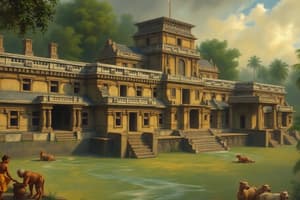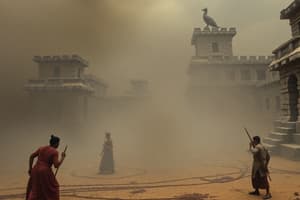Podcast
Questions and Answers
Which civilization is considered the mother civilization of Central America?
Which civilization is considered the mother civilization of Central America?
- Teotihuacan
- Maya
- Toltecs
- Olmecs (correct)
Where did the Maya civilization arise?
Where did the Maya civilization arise?
- Tikal
- Guatemalan highlands and the Yucatan Peninsula (correct)
- Valley of Mexico
- Southern Mexico
What is Tenochtitlan known as today?
What is Tenochtitlan known as today?
- Tikal
- Chichen Itza
- Mexico City (correct)
- Teotihuacan
During which period did the Maya civilization experience prosperity and scientific achievements?
During which period did the Maya civilization experience prosperity and scientific achievements?
What was a major driving force behind the Spanish economy in New Spain?
What was a major driving force behind the Spanish economy in New Spain?
What was the impact of the Bourbon reforms on the New World?
What was the impact of the Bourbon reforms on the New World?
What event led to the loss of nearly half of Mexico's territory?
What event led to the loss of nearly half of Mexico's territory?
What was the significance of the Battle of Puebla?
What was the significance of the Battle of Puebla?
Who led a coup against the president in 1876, establishing order but also encouraging foreign investment and modernization?
Who led a coup against the president in 1876, establishing order but also encouraging foreign investment and modernization?
What triggered the Mexican Revolution in 1910?
What triggered the Mexican Revolution in 1910?
Flashcards are hidden until you start studying
Study Notes
- The samurai limited edition pin is available now.
- Mesoamerica, specifically southern Mexico, was an ideal place to start a civilization due to its stable climate, access to water, and abundant staple food crop, maize.
- The Olmecs, considered the mother civilization of Central America, emerged along with culture and trade.
- Mesoamerican civilization spread along old trade routes, with the Maya civilization arising in the Guatemalan highlands and the Yucatan Peninsula.
- The Maya civilization was prosperous during the classical period and is known for its scientific achievements, including the long count calendar.
- The Maya civilization experienced a mysterious collapse, with abandoned cities and defunct trade networks.
- Teotihuacan was a powerful city-state in the Valley of Mexico that ruled trade between the south and the north.
- Teotihuacan's hostile takeover of Tikal led to a war between the two powerful cities and the eventual collapse of the Maya civilization.
- The Toltecs rose to power after the collapse of Teotihuacan.
- The Aztecs formed an alliance of three former Toltec cities and built a massive city, Tenochtitlan, which became the heart of the Aztec empire.
- The Aztecs are known for their extensive practice of human sacrifice and their conquests were facilitated through ritual warfare.
- The Spanish arrived in Central America during the Columbian Exchange, a period of massive cultural, religious, and economic exchange between the Eastern and Western hemispheres.
- Spanish conquistadors, driven by wealth and the goal of converting indigenous peoples to Christianity, began to conquer Central America, leading to the downfall of many indigenous civilizations.
- The Spanish conquest was particularly devastating due to the spread of diseases, such as smallpox, to which the indigenous populations had no immunity.
- New Spain's silver production was a major driving force behind the Spanish economy and led to inflation and economic instability.
- The Spanish enforced a strict caste system, defining a social hierarchy on racial grounds and making it harder for the disenfranchised to succeed in society.
- The Spanish brought Catholicism to Mexico and the unique blend of Christian beliefs and American traditions formed a distinct flavor of Christianity.
- The Bourbon reforms aimed to boost production and exports in the New World and make the colony more economically dependent on Spain, leading to growing discontent among the population.
- The Mexican War of Independence lasted 11 years and was fought against both Napoleonic and restored Bourbon forces.
- Mexico was founded on the principles of unity, independence, and Catholicism.
- After independence, Mexico was split into liberal and conservative factions, leading to instability and constant overthrowing of one another.
- Central America politely opted out in 1823.- In 1835, Texas opted out of the second Mexican Republic and wanted to rejoin the US, but this was difficult as the US had annexed Texas in 1845.
- Mexico fought a devastating war with the US, losing Texas and nearly half of their territory.
- The unpopular Mexican President, Lopez de Santa Anna, was exiled in 1855, the same year liberal reform began.
- The liberal reform, which was unpopular with conservatives, led to the Reform War.
- Mexico owed significant debt to France, who saw an opportunity to work with conservative monarchists to bring back the Mexican Empire.
- The Battle of Puebla on Cinco de Mayo in 1862 was a significant victory for Mexico against the French, boosting morale.
- Porfirio Diaz led a coup against the president in 1876, establishing order but also encouraging foreign investment and modernization.
- Diaz served seven terms as president but failed to make a plan for a world without himself, leading to the Mexican Revolution in 1910.
- Francisco Madero was elected president but was unpopular with both the left and the right, leading to his ousting and assassination.
- The Mexican Civil War followed, with 1.5 million lives lost and lasting until the constitutionalist faction of Venustiano Carranza was victorious.
- Mexico experienced a series of unstable presidencies and another war, the Cristero War, for religious freedom, lasting until the 1920s.
- Plutarco Elias Calles came to power, believing the root of Mexico's problems was Catholicism, leading to another war.
- The political party established by these revolutionary presidents remained in power in Mexico until 2000.
- Mexico's history is characterized by deeply entrenched political status quo, class warfare, and instability.
- Change is sometimes slow and does not necessarily benefit everyone, and people may take extreme measures to bring about change, regardless of personal gain.
- Mexico's history is a reminder that stability is not always a luxury and that the consequences of colonialism are complex and multifaceted.
- Hernan Cortes is a controversial figure in Mexican and world history, and it is important to understand the less savory periods for intellectual honesty.
- Curiosity Stream offers access to thousands of documentaries and educational content, including a series on the butterfly effect and the history of Mexico.
- Nebula is a platform where creators can make different content and take risks, and Curiosity Stream supports both the platform and this channel.
Studying That Suits You
Use AI to generate personalized quizzes and flashcards to suit your learning preferences.




